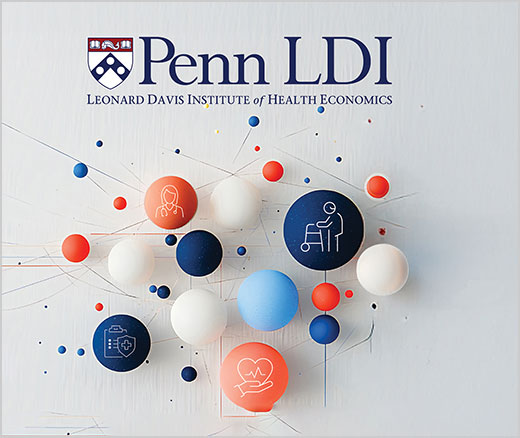
University of Pennsylvania Teams Up with CenterWell to Help Advance Primary Care Excellence and Access for Seniors
New Program Launches Research Initiatives Focused on Improving Primary Care for Older Adults
Improving Care for Older Adults
Blog Post

Medicare Advantage was created to control costs and promote choice. For people over age 65, this insurance option pays health care organizations a set amount per beneficiary. In contrast, traditional Medicare pays per visit, test, or treatment, incentivizing more services and costs.
Although Medicare Advantage has grown to cover more than half of Medicare recipients, these plans have not reduced the overall per-beneficiary cost and questions remain about quality, including in post-hospitalization settings like post-acute care, where costs can be high. LDI Senior Fellow Robert Burke, LDI Executive Director Rachel M. Werner, and colleagues used a 2015-2019 Medicare dataset for a direct, head-to-head comparison of Medicare Advantage and traditional Medicare for the use of skilled nursing facilities (SNFs) and home health after a hospitalization.
The researchers had several hypotheses. One was that Medicare Advantage plans would limit the initiation of post-acute care after a hospitalization as a way to control costs, so fewer beneficiaries would receive this care than traditional Medicare recipients. Plans can also substitute more inexpensive home care for more expensive SNF care, so another prediction was that home health use would be higher with Medicare Advantage versus traditional Medicare. Plans can control the number of days of care, so fewer were expected under Medicare Advantage.
Finally, Medicare Advantage can control which providers patients can use, so the team expected smaller provider networks than with traditional Medicare, possibly as a way to increase post-acute care value, which was measured by providers’ five-star quality ratings. Burke answered questions about the study’s unexpected results.
Burke: Post-acute care is a focus of cost containment for both Medicare Advantage and traditional Medicare, since more than 40% of beneficiaries receive this care at a cost of more than $60 billion annually for traditional Medicare alone. In addition, previous studies didn’t look at hospitalization rates, which is the reason people need this care, so we calculated those trends, for context.
We had data on more than 27 million Medicare beneficiaries who were hospitalized in the five years before the COVID-19 pandemic. The groups were similar, although Medicare Advantage recipients were a little younger and more racially and ethnically diverse. We excluded anyone with recent hospital, SNF, or home health care use, because we were interested in peoples’ new decisions about post-acute care.

Burke: We found that hospitalization rates decreased, by a few percentage points, for both Medicare Advantage and traditional Medicare. Over the five years preceding the pandemic, rates were 16% for traditional Medicare and 12% for Medicare Advantage but both trended downward. Many hospital-related policies, programs, and practices probably contributed to these trends.
An unexpected result was the patterns of post-acute care utilization, particularly for SNFs. Given the high costs of these facilities and efforts to reign in that spending, we expected their use to be significantly lower in Medicare Advantage, but it was only slightly lower. The Medicare Advantage and traditional Medicare groups both used more SNFs than home health: For Medicare Advantage, utilization rates were 19% for SNFs and 13% for home health, and for traditional Medicare, 21% for SNFs and 15% for home health.
I was surprised because I work in a hospital and know that Medicare Advantage can require prior authorization for post-acute care. It’s thought to be easier to get this authorization for home health, which costs about $2,000, compared to SNFs, which cost about $12,000. One would think Medicare Advantage plans would encourage home health use. But our results didn’t show a big difference between insurance types in nursing facility use.
As we expected, Medicare Advantage patients had fewer days of post-acute care than traditional Medicare patients—a median of 23 days versus 25 days. That has a big effect over 27 million hospitalizations.
Burke: Also as we expected, Medicare Advantage used a smaller network of providers than traditional Medicare—a median of 20 versus 32. We hypothesized a narrower network meant hospitals wanted the highest quality care for Medicare Advantage patients, but overall five-star quality ratings were an average of 0.1 point lower for Medicare Advantage versus traditional Medicare providers.
One reason might be that the Medicare Advantage and traditional Medicare populations were a little different. Maybe Medicare Advantage patients had fewer local five-star SNFs to choose from. The result might also reflect Medicare Advantage plans’ preferences about SNFs and home health agencies they use.
Burke: The most important question to answer is: Does the reduction in length of post-acute care and possibly lower quality of SNF and home health options have long-term health implications for Medicare Advantage beneficiaries?
We’re studying if these findings change Medicare Advantage recipients’ mortality, hospital readmissions, or long-term nursing home stays. We’re examining whether the type and length of post-acute care differs by Medicare Advantage plan.
This is so important because Medicare Advantage represents one of the largest national changes in approaches to post-acute care. While Medicare Advantage sometimes gets a bad rap because plans come from private, sometimes for-profit insurers, our results could challenge preconceptions if Medicare Advantage is in fact equally or more efficient than traditional Medicare.
The study, “Trends in Post-Acute Care Use in Medicare Advantage Versus Traditional Medicare: A Retrospective Cohort Analysis,” was published on August 15, 2024 in the Journal of the American Medical Directors Association. Authors include Robert E. Burke, Indrakshi Roy, Franya Hutchins, Song Zhong, Syama Patel, Liam Rose, Amit Kumar, and Rachel M. Werner.



New Program Launches Research Initiatives Focused on Improving Primary Care for Older Adults

Home Care May be Hardest Hit, LDI’s Rachel M. Werner Tells Marketplace’s Make Me Smart Podcast

If Federal Support Falls, States May Slash Home- and Community-Based Services — Pushing Vulnerable Americans Into Nursing Homes They Don’t Want or Need

Men are Stepping Up at Home, but Caregiving Still Falls On Women and People of Color LDI Fellow Says

Economist Norma Coe’s Caregiving For Relatives Informed Her Research

The Decline Since 2020 May Signal Gaps in Service and Access